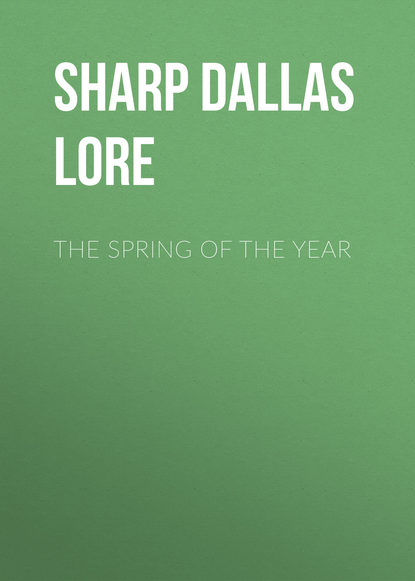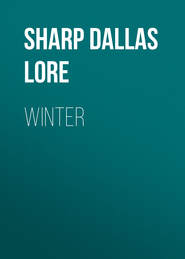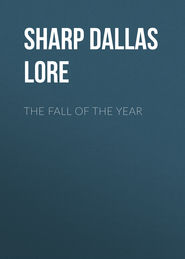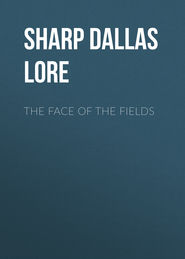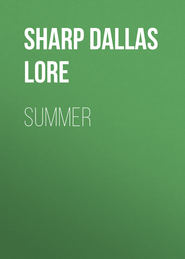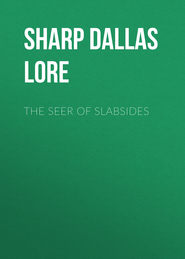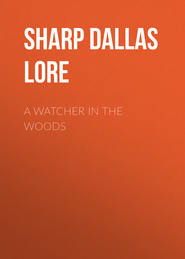По всем вопросам обращайтесь на: info@litportal.ru
(©) 2003-2024.
✖
The Spring of the Year
Настройки чтения
Размер шрифта
Высота строк
Поля
for him to call the summer rain: alluding to his evening and his cloudy-day call as a sign of coming rain.
Page 22
castings: the disgorged lumps of hair and bones of the small animals eaten by the owls.
Page 24
Altair and Arcturus: prominent stars in the northern hemisphere.
CHAPTER IV
TO THE TEACHER
See the suggestions for the corresponding chapter in “The Fall of the Year,” the first volume in this series. Lest you may not have that book at hand, let me repeat here the gist of what I said there: that you make this chapter the purpose of one or more field excursions with the class – in order to see with your own eyes the characteristic sights of spring as recorded here; secondly, that you use this, and chapters VI and X, as school tests of the pupil’s knowledge and observation of his own fields and woods; and thirdly, let the items mentioned here be used as possible subjects for the pupil’s further study as themes for compositions, or independent investigations out of school hours. The finest fruit the teacher can show is a school full of children personally interested in things. And what better things than live things out of doors?
CHAPTER V
TO THE TEACHER
I might have used a star, or the sun, or the sea to teach the lesson involved here, instead of the crow and his three broken feathers. But these three feathers will do for your pupils as the falling apple did for Sir Isaac Newton. The point of the chapter is: that the feathers like the stars must round out their courses; that this universe is a universe of law, of order, and of reason, even to the wing feathers of a crow. Try to show your pupils the beauty and wonder of order and law (not easy to do) as well as the beauty and wonder of shapes and colors and sounds, etc.
FOR THE PUPIL
Page 34
primaries, secondaries, tertials: Turn to your dictionary under “Bird” (or at the front of some good bird book) and study out just which feathers of the wing these named here are.
Page 35
half-moulted hen: Pick her up and notice the regular and systematic arrangement of the young feathers. Or take a plucked hen and draw roughly the pin-feather scheme as you find it on her body.
Page 37
reed-birds: The bobolink is also called “rice-bird” from its habit of feeding in the rice-fields of the South on its fall migration.
CHAPTER VI
FOR THE PUPIL
Do not stop doing or seeing or hearing when you have done, seen, and heard the few things suggested in this chapter and in chapters IV and X; for these are only suggestions, and merely intended to give you a start, as if your friend had said to you upon your visiting a new city, “Now, don’t fail to see the Common and the old State House, etc.; and don’t fail to go down to T Wharf, etc.,” – knowing that all the time you would be doing and seeing and hearing a thousand interesting things.
CHAPTER VII
TO THE TEACHER
I called this chapter when I first wrote it “The Friendship of Nature” – a much used title, but entirely suggestive of the thought and the lesson in the story here. This was first written about six years ago, and to-day, May 12, 1912, that pair of phœbes, or another pair, have their nest out under the pig-pen roof as they have had every year since I have known the pen. Repeat and expand the thought as I have put it into the mouth of Nature in the first paragraph – “We will share them [the acres] together.” Instill into your pupils’ minds the large meaning of obedience to Nature’s laws and love for her and all her own. Show them also how ready Nature is (and all the birds and animals and flowers) to be friendly; and how even a city dooryard may hold enough live wild things for a small zoo. This chapter might well be made use of by the city teacher to stir her pupils to see what interesting live things their city or neighborhood has, although the woods and open fields are miles away.
FOR THE PUPIL
Page 48
a hornet’s nest: the white-faced hornet, that builds the great cone-shaped paper nests.
swifts thunder in the chimney: See chapter VII (and notes) in “Winter.” For the “thunder” see section IX in chapter X of this book.
Page 49
cabbage butterfly: a pest; a small whitish butterfly with a few small black spots. Its grubs eat cabbage.
Page 54
the crested flycatcher: is the largest of the family; builds in holes; distinguished by its use of cast-off snake-skins in its nests.
kingbird: Everybody knows him, for it is usually he who chases the marauding crows; he builds, out in the apple tree if he can, a big, bulky nest with strings a-flying from it: also called “bee-martin,” a most useful bird.
wood pewee: builds on the limbs of forest trees a most beautiful nest, much like a hummingbird’s, only larger. Pewee’s soft, pensive call of “pe-e-e-wee” in the deep, quiet, dark-shrouded summer woods is one of the sweetest of bird notes.
chebec: a little smaller than a sparrow; builds a beautiful nest in orchard trees and says “chebec, chebec, chebec.”
Page 58
One had died: After phœbe brings off her first brood sprinkle a little, tobacco-dust or lice-powder, such as you use in the hen-yard, into the nest to kill the vermin. Otherwise the second and third broods may be eaten alive by lice or mites.
CHAPTER VIII
TO THE TEACHER
In “Winter” I put a chapter called “The Missing Tooth,” showing the dark and bitter side of the life of the wild things; here I have taken that thought as most people think of it (see Burroughs’s essay, “A Life of Fear” in “Riverby”) and in the light of typical examples tried to show that wild life is not fear, but peace and joy. The kernel of the chapter is found in the words: “The level of wild life, the soul of all nature, is a great serenity.” Let the pupils watch and report instances of fear (easy to see) and in the same animals instances of peace and joy.
FOR THE PUPIL
Page 60
gray harrier: so named because of his habit of flying low and “harrying,” that is, hunting, catching small prey on or near the ground. “Harry” comes from the Anglo-Saxon word for army.
Page 61
“He looketh as it were a grym leoun”: from Chaucer’s description of the Cock in the story of the Cock and the Fox.
Page 62
terrible pike: closely related to the pickerel.
kingfisher: builds in holes in sand-banks near water. Its peculiar rattle sounds like the small boys’ “clapper.”
Page 63
“The present only toucheth thee!”: Burns’s poem “To a Mouse.”
Page 22
castings: the disgorged lumps of hair and bones of the small animals eaten by the owls.
Page 24
Altair and Arcturus: prominent stars in the northern hemisphere.
CHAPTER IV
TO THE TEACHER
See the suggestions for the corresponding chapter in “The Fall of the Year,” the first volume in this series. Lest you may not have that book at hand, let me repeat here the gist of what I said there: that you make this chapter the purpose of one or more field excursions with the class – in order to see with your own eyes the characteristic sights of spring as recorded here; secondly, that you use this, and chapters VI and X, as school tests of the pupil’s knowledge and observation of his own fields and woods; and thirdly, let the items mentioned here be used as possible subjects for the pupil’s further study as themes for compositions, or independent investigations out of school hours. The finest fruit the teacher can show is a school full of children personally interested in things. And what better things than live things out of doors?
CHAPTER V
TO THE TEACHER
I might have used a star, or the sun, or the sea to teach the lesson involved here, instead of the crow and his three broken feathers. But these three feathers will do for your pupils as the falling apple did for Sir Isaac Newton. The point of the chapter is: that the feathers like the stars must round out their courses; that this universe is a universe of law, of order, and of reason, even to the wing feathers of a crow. Try to show your pupils the beauty and wonder of order and law (not easy to do) as well as the beauty and wonder of shapes and colors and sounds, etc.
FOR THE PUPIL
Page 34
primaries, secondaries, tertials: Turn to your dictionary under “Bird” (or at the front of some good bird book) and study out just which feathers of the wing these named here are.
Page 35
half-moulted hen: Pick her up and notice the regular and systematic arrangement of the young feathers. Or take a plucked hen and draw roughly the pin-feather scheme as you find it on her body.
Page 37
reed-birds: The bobolink is also called “rice-bird” from its habit of feeding in the rice-fields of the South on its fall migration.
CHAPTER VI
FOR THE PUPIL
Do not stop doing or seeing or hearing when you have done, seen, and heard the few things suggested in this chapter and in chapters IV and X; for these are only suggestions, and merely intended to give you a start, as if your friend had said to you upon your visiting a new city, “Now, don’t fail to see the Common and the old State House, etc.; and don’t fail to go down to T Wharf, etc.,” – knowing that all the time you would be doing and seeing and hearing a thousand interesting things.
CHAPTER VII
TO THE TEACHER
I called this chapter when I first wrote it “The Friendship of Nature” – a much used title, but entirely suggestive of the thought and the lesson in the story here. This was first written about six years ago, and to-day, May 12, 1912, that pair of phœbes, or another pair, have their nest out under the pig-pen roof as they have had every year since I have known the pen. Repeat and expand the thought as I have put it into the mouth of Nature in the first paragraph – “We will share them [the acres] together.” Instill into your pupils’ minds the large meaning of obedience to Nature’s laws and love for her and all her own. Show them also how ready Nature is (and all the birds and animals and flowers) to be friendly; and how even a city dooryard may hold enough live wild things for a small zoo. This chapter might well be made use of by the city teacher to stir her pupils to see what interesting live things their city or neighborhood has, although the woods and open fields are miles away.
FOR THE PUPIL
Page 48
a hornet’s nest: the white-faced hornet, that builds the great cone-shaped paper nests.
swifts thunder in the chimney: See chapter VII (and notes) in “Winter.” For the “thunder” see section IX in chapter X of this book.
Page 49
cabbage butterfly: a pest; a small whitish butterfly with a few small black spots. Its grubs eat cabbage.
Page 54
the crested flycatcher: is the largest of the family; builds in holes; distinguished by its use of cast-off snake-skins in its nests.
kingbird: Everybody knows him, for it is usually he who chases the marauding crows; he builds, out in the apple tree if he can, a big, bulky nest with strings a-flying from it: also called “bee-martin,” a most useful bird.
wood pewee: builds on the limbs of forest trees a most beautiful nest, much like a hummingbird’s, only larger. Pewee’s soft, pensive call of “pe-e-e-wee” in the deep, quiet, dark-shrouded summer woods is one of the sweetest of bird notes.
chebec: a little smaller than a sparrow; builds a beautiful nest in orchard trees and says “chebec, chebec, chebec.”
Page 58
One had died: After phœbe brings off her first brood sprinkle a little, tobacco-dust or lice-powder, such as you use in the hen-yard, into the nest to kill the vermin. Otherwise the second and third broods may be eaten alive by lice or mites.
CHAPTER VIII
TO THE TEACHER
In “Winter” I put a chapter called “The Missing Tooth,” showing the dark and bitter side of the life of the wild things; here I have taken that thought as most people think of it (see Burroughs’s essay, “A Life of Fear” in “Riverby”) and in the light of typical examples tried to show that wild life is not fear, but peace and joy. The kernel of the chapter is found in the words: “The level of wild life, the soul of all nature, is a great serenity.” Let the pupils watch and report instances of fear (easy to see) and in the same animals instances of peace and joy.
FOR THE PUPIL
Page 60
gray harrier: so named because of his habit of flying low and “harrying,” that is, hunting, catching small prey on or near the ground. “Harry” comes from the Anglo-Saxon word for army.
Page 61
“He looketh as it were a grym leoun”: from Chaucer’s description of the Cock in the story of the Cock and the Fox.
Page 62
terrible pike: closely related to the pickerel.
kingfisher: builds in holes in sand-banks near water. Its peculiar rattle sounds like the small boys’ “clapper.”
Page 63
“The present only toucheth thee!”: Burns’s poem “To a Mouse.”





